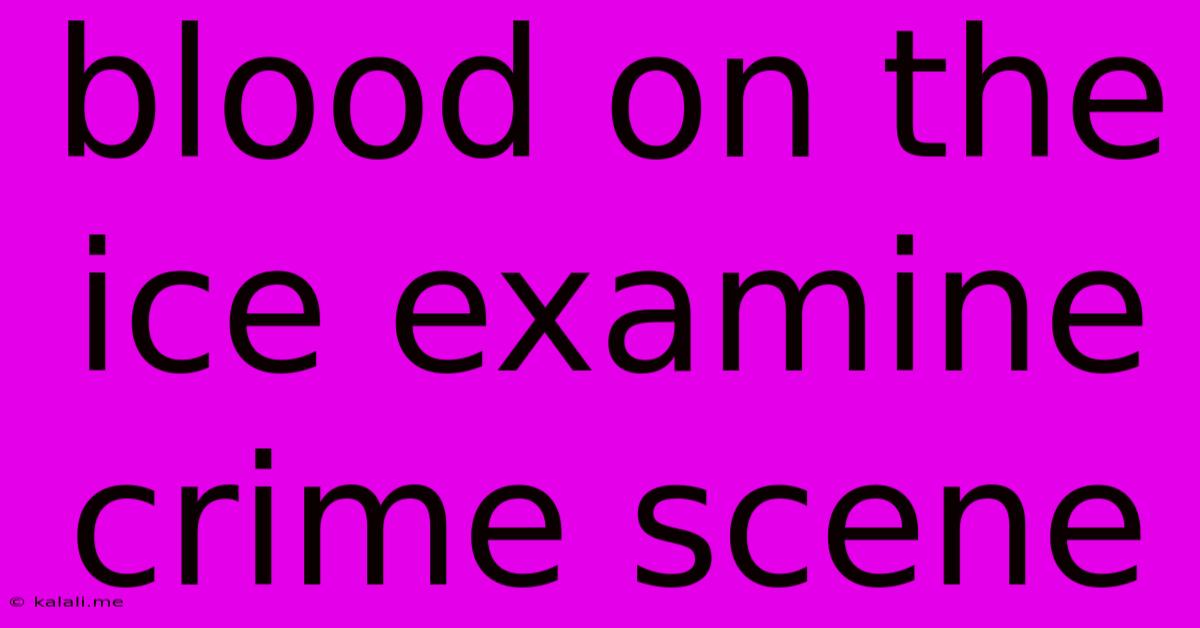Blood On The Ice Examine Crime Scene
Kalali
May 25, 2025 · 3 min read

Table of Contents
Blood on the Ice: A Crime Scene Examination Deep Dive
Meta Description: Delve into the intricacies of a bloodstain pattern analysis at a crime scene, exploring the techniques used to interpret blood spatter, determine the weapon used, and reconstruct the events leading to the crime. Learn about the crucial role of blood evidence in solving violent crimes.
The chilling discovery of blood at a crime scene immediately elevates the stakes. It's not merely evidence; it's a silent witness, capable of narrating a story far more complex than any eye-witness account. This article will explore the meticulous process of examining blood evidence, focusing on bloodstain pattern analysis (BPA) and its critical role in reconstructing the events surrounding a violent crime. We'll delve into the techniques utilized by forensic experts to interpret the "message" left behind by blood, helping to solve even the most baffling cases.
Understanding Bloodstain Patterns: A Silent Storyteller
Bloodstain pattern analysis is a crucial forensic discipline. Unlike simply noting the presence of blood, BPA focuses on the characteristics of the stains. These characteristics, such as size, shape, and distribution, can provide invaluable insights into the events leading to the bloodshed. For instance:
- Passive Bloodstains: These are formed due to gravity, such as drops, flows, and pools. Their size and shape can indicate the position of the victim and the passage of time.
- Projected Bloodstains: These result from force, such as impact spatter (from a blunt force trauma), cast-off spatter (from a weapon), or arterial spurts (from a severed artery). The pattern can reveal the type of weapon used, the direction of the force, and the number of blows.
- Transfer Bloodstains: These are created when a bloody object comes into contact with a surface, leaving a partial or complete imprint. They can identify the type of object and even the movement of the perpetrator.
Analyzing these patterns requires expert knowledge of blood dynamics, physics, and mathematics. Forensic experts meticulously document the location, size, and shape of each stain, using photography, sketches, and even 3D scanning technology. This detailed documentation forms the foundation for reconstructing the crime scene.
Beyond the Stains: Connecting the Dots
BPA isn't just about identifying the patterns; it's about interpreting their significance within the larger context of the crime scene. Experts consider several factors including:
- The victim's position: Where was the victim located when the bloodshed occurred? This can be deduced from the distribution and concentration of bloodstains.
- The weapon used: The type of weapon (blunt force, sharp force, firearm) can often be inferred from the characteristics of the blood spatter.
- The sequence of events: By analyzing the different types of stains and their spatial relationships, investigators can reconstruct the timeline of the events, from the initial attack to the final moments.
- The movement of the perpetrator and victim: The patterns can indicate the movement of both the victim and the attacker during and after the crime.
Advanced Techniques in Bloodstain Analysis
Modern forensic science is constantly evolving, incorporating new technologies to enhance the accuracy and efficiency of bloodstain analysis. Some of these techniques include:
- DNA analysis: Bloodstains can be subjected to DNA testing to identify the victim and/or the perpetrator. This powerful tool can confirm suspicions and provide crucial evidence for prosecution.
- Luminol testing: Luminol is a chemical reagent that reacts with blood, making it visible even after cleaning attempts. It’s particularly useful in identifying hidden or cleaned-up bloodstains.
- 3D scanning and modeling: Sophisticated 3D scanning techniques create accurate digital models of the crime scene, allowing for detailed analysis of bloodstain patterns and spatial relationships.
Conclusion: The Power of Silent Evidence
Blood evidence, particularly through the meticulous analysis of bloodstain patterns, plays a critical role in solving violent crimes. The information gleaned from a careful examination of blood spatter can reveal crucial details about the events leading to the crime, helping investigators piece together the puzzle and bring perpetrators to justice. The combination of traditional forensic techniques and advanced technologies ensures that even the smallest bloodstain can speak volumes, offering invaluable insights into the unfolding of a tragic event.
Latest Posts
Latest Posts
-
How To Know If Propane Tank Is Empty
May 25, 2025
-
What Part Of Speech Is All
May 25, 2025
-
What Does Guido Say In Cars
May 25, 2025
-
Is Jehovah Witness And Mormon The Same
May 25, 2025
-
Iterm2 Send Command To All Panes
May 25, 2025
Related Post
Thank you for visiting our website which covers about Blood On The Ice Examine Crime Scene . We hope the information provided has been useful to you. Feel free to contact us if you have any questions or need further assistance. See you next time and don't miss to bookmark.